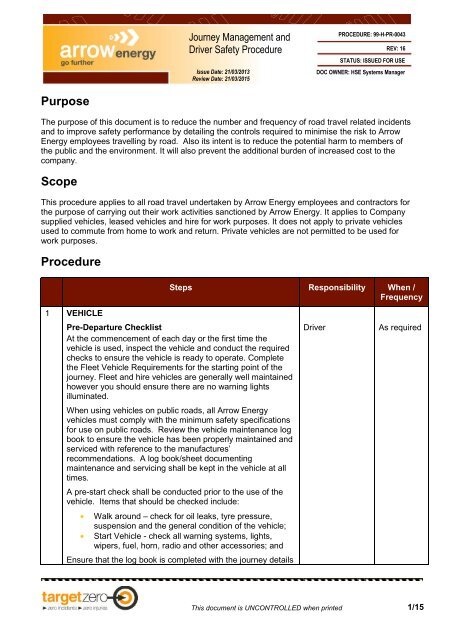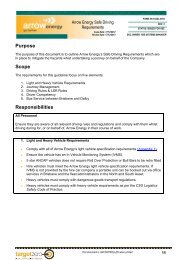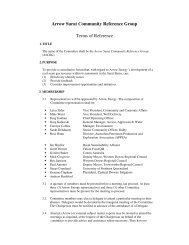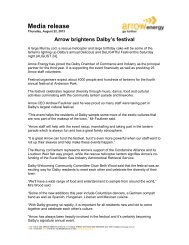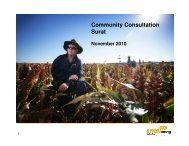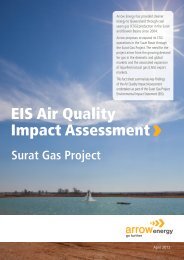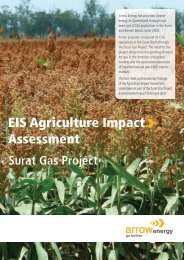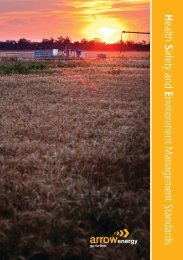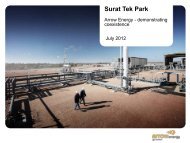Template - Procedure - Arrow Energy
Template - Procedure - Arrow Energy
Template - Procedure - Arrow Energy
You also want an ePaper? Increase the reach of your titles
YUMPU automatically turns print PDFs into web optimized ePapers that Google loves.
JOURNEY MANAGEMENT AND DRIVER SAFETY99-H-PR-0043off road or on an unsealed road the speed limits are60km/h for non gazetted roads and 80km/h forgazetted roads.EXEMPTIONS: TRUCKS AND MACHINERYWITHOUT 4WDCAPABILITY ARE PERMITTED TO DRIVEON UNSEALEDROADS.10 Road Surface ConditionsAll drivers need to drive to the conditions of the road. Beprepared for pot holes and damaged or uneven road surface.Ensure there is adequate distance between your vehicle andthe vehicle travelling in front of you to react to any roadsurface damage.Adjust/decrease vehicle speed to suit conditions,particularly on wet sections and corners;Stay on formed roads whenever possible;Avoid sudden changes in speed/direction;Country roads can be narrow, unsealed, have no kerbs orguttering, potentially unsafe crests and curves, are generallyof a lower standard than urban roads and are often poorlymaintained.11 Water on RoadFlooded roads or creek crossings are unsafe. Considerturning back and seeking alternative routes or overnightaccommodation to wait out the flood.Do not enter waters where the depth of water and thecondition of the bottom cannot be safely verified or the flowappears excessive or unsafe.Do not cross water where the flow is over the midpoint of thewheel.12 Wildlife on RoadsRemain aware of the potential for wildlife to enter theroadway. Scan sides of roads for wildlife; if an animal is onthe road, brake slowly, sound the horn and flash theheadlights. Remember that striking a small animal may besafer than a violent swerve of the vehicle. Be aware of stockthat enter the roadway do not agitate stock on grazing land.Avoid where practical travelling at dawn, dusk and at night.13 Driving Into the SunWhere possible plan your journey accordingly to avoid thesun’s glare when the sun is rising and setting over thehorizon.DriverDriverDriverDriverAs requiredAs requiredAs requiredAs requiredSTATUS: Issued for Use REV: 16 DOC AUTHOR: Senior HSE Advisor – Special ProjectsThis document is UNCONTROLLED when printed 6/15
JOURNEY MANAGEMENT AND DRIVER SAFETY99-H-PR-004314 Weather ConditionsIn rain or storms, visibility is impaired, and roads becomeslippery. Slow down. Increase the distance between yourvehicle and traffic in front of you. Take turns carefully andsmoothly.15 Interaction with Heavy and Oversize VehiclesHeavy vehicles present hazards for other road users, whichinclude generating a large amount of spray in rainyconditions; requiring longer stopping, overtaking, turning andseparation distances; and causing significant aerodynamicdisturbances alongside and behind them at highway speeds.When interacting with heavy vehicles on the road, be mindfulthat their physical and mechanical characteristics necessitatea different driving style. In particular, leave greater distancesthan usual between your vehicle and trucks. Note that truckdrivers may try to gather momentum downhill for the nextuphill run. Keep out of their way as much as possible.Give long and heavy vehicles plenty of turning space.Remember that truck and bus drivers generally do not havethe unrestricted rear view that car drivers have. If you cannotsee the driver's face in the side mirror of the truck, assumethat the driver is unaware of your presence. Avoid locatingyour vehicle in a driver's blind spots (eg beside a truckunderneath the line of sight of the side mirrors).16 Driving at NightBecome familiar with the operation of the car lights beforenightfall. Be especially mindful of wildlife at night and at duskor dawn. As night driving increases the risk due to reducedvisibility and the potential for increased fatigue, Supervisorsmust be aware of the journeys their staff are taking andwhere possible minimise the night travel.17 RoadworksBe aware of damaged, uneven or deteriorated road surface.Unstable road edges may exist during road works. Adhere toall road works signage. Take guidance from traffic controllers.Adhere to reduced speed limits.18 Reversing VehiclesReversing of vehicles is one of the major causes of vehicleaccidents. Drivers should take extreme care when reversing.Where possible, drivers should park vehicles so the need toreverse the vehicle when departing is eliminated.When reversing, be especially aware of pedestrians and/orchildren who could be at the sides or rear of the car.When reversing you are required to give way to allother traffic and/or pedestrians.Try to keep the steering wheel as straight as possible.DriverDriverDriverDriverDriverAs requiredAs requiredAs requiredAs requiredAs requiredSTATUS: Issued for Use REV: 16 DOC AUTHOR: Senior HSE Advisor – Special ProjectsThis document is UNCONTROLLED when printed 7/15
JOURNEY MANAGEMENT AND DRIVER SAFETY99-H-PR-004319 OvertakingAny movements with the steering wheel should be assmall as possible.Take your time. Don’t attempt to reverse too quickly.If you find that the car is well off course, stop, anddrive forward and straighten the car, then resumereversing.If it is safe to do so get out of your vehicle and checkwhat is around and behind it before reversingWear your seatbeltThere may be limited opportunities to overtake on thejourney. Plan your journey to ensure you have allowedadequate time to arrive at your destination. It is against thelaw to speed therefore overtaking another vehicle must bedone within the designated speed limit.20 Road ClosuresThere is always a possibility of road closures due to vehicleaccidents or road conditions. Consider alternative routeswhen considering your route prior to travel.21 Debris on the RoadEnsure the vehicle windscreen is clean. Use the vehiclelights. Reduce travelling speed to increase availableresponse times. Maintain adequate separation distance fromthe vehicle travelling in front.22 Merging LanesTake caution when approaching merging lanes. The vehiclein front has priority when merging.23 Unauthorised PassengersDo not allow un authorized passengers to undertake thejourney in the vehicle you are driving. Do not pick up hitchhikers.24 Vehicle RecoveryIf a light vehicle becomes bogged in mud or sand, there arevarious methods, depending on conditions and equipmentavailability, for recovering the vehicle. Refer to the followingGuidelines:Recovery by Towing 99-H-GDL-0068Recovery by Winching Solid Object 99-H-GDL-0069Recovery using Winch 99-H-GDL-0070DriverDriverDriverDriverDriverAs requiredAs requiredAs requiredAs requiredAs requiredSTATUS: Issued for Use REV: 16 DOC AUTHOR: Senior HSE Advisor – Special ProjectsThis document is UNCONTROLLED when printed 8/15
JOURNEY MANAGEMENT AND DRIVER SAFETY99-H-PR-004325 Emergency ResponseEnsure you have communication capability (radio, mobile/satellite phone, tracking unit e.g. Spot or the panic alertswitch on the IVMS unit in the event of an emergencyShould you be involved in an emergency situation thefollowing agencies may required to be contactedPolice - 000;Mobile emergency number – 112; and/orCompany 1800 emergency number- 1800 779 488Drivers must not rely on the panic alert from the IVMS unit foremergency response, drivers must ensure that othercommunication mechanisms are in place and have plannedappropriately with the Journey Monitoring Centre and with theappropriate supervisor or nominated emergency contactperson.Drivers should provide their supervisor or emergency contactperson with information such as home phone numbers,destination, contact person at destination, ETA, and any otherrelevant information to assist in locating the driver if required.26 DRIVERDriver Competency<strong>Arrow</strong> <strong>Energy</strong> requires all drivers to be competent as per thecompetency requirements set by APPEA in the CSG DriverCompetencies standard. These competencies will berecognised for 5 years at which time re-certification must betaken by the driver.Drivers are allowed to drive once per year without thesecompetencies with a deviation however must be booked intoa course prior to seeking the deviation.The following Light Vehicle driver competency is mandatoryfor all <strong>Arrow</strong> <strong>Energy</strong> employees and contractor light vehicledrivers when driving on a sealed road only:RIIVEH201A – Operate Light Vehicle.Further, those employees or contractors who shall beoperating their vehicles in off-road conditions shall attain thefollowing competency:DriverDriverAs requiredAs requiredRIIVEH305A – Operate and Maintain a Four-Wheel Drive.OR;PMASUP236B – Operate Vehicles in the field.Before you arrange for a vehicle for travel, ensure that youhave a current licence for the specific vehicle and theappropriate APPEA competency. Comply with all conditionsand restrictions on your licence. It is recommended that youhave your driver’s licence in your possession when you travelon company business.STATUS: Issued for Use REV: 16 DOC AUTHOR: Senior HSE Advisor – Special ProjectsThis document is UNCONTROLLED when printed 9/15
JOURNEY MANAGEMENT AND DRIVER SAFETY99-H-PR-0043Heavy vehicle drivers must hold the licence appropriate to theclass of vehicle they are driving, i.e.Light Rigid (LR) – A vehicle with a GVM of more than 4.5tonnes and less than 8 tonnes.Medium Rigid (MR) – A vehicle with a GVM of more than 8tonnes but no more than two axles.Heavy Rigid (HR) – A vehicle with a GVM of more than 8tonnes with more than two axles with or without a trailer of notmore than 9 tonnes GVM.Heavy Combination (HC) – A vehicle with a GVM of morethan 8 tonnes with a trailer of more than 9 tonnes.Multi-Combination (MC) – A B-double or Road Train.27 Wearing Seat Belts28 Driver FatigueDURING VEHICLE OPERATIONOCCUPANTS MUST WEAR SEATBELTS ATALL TIMES.The following requirements will apply to minimise driverfatigue• The maximum driving / work hours in any 24hourperiod is 12 hours. Any further driving /work time to alimit of 14 hours (not including heavy vehicles) wouldrequire an assessment to be conducted and signoff bya Supervisor. Call out work responding to anemergency may be approved at the discretion of theLine Manager. This is also applicable to heavyvehicles.Drivers must not exceed driving for greater than 2hours. It is mandatory that drivers take at least a 15minute break in the journey prior to reaching 2 hoursthroughout the trip. Breaks are especially required if adriver is exhibiting signs of fatigue for example,yawning, micro sleeps etc.Where possible journeys should be undertaken indaylight hours.When travelling at night it is recommended that apassenger travel in the vehicle where possible.Other than shift work, Supervisors should challengethe need to drive at night.Failure to abide by this rule may result in an LSRbreach.If you are taking any medication, check whether it causesdrowsiness.DriverDriverAs requiredAs requiredSTATUS: Issued for Use REV: 16 DOC AUTHOR: Senior HSE Advisor – Special ProjectsThis document is UNCONTROLLED when printed 10/15
JOURNEY MANAGEMENT AND DRIVER SAFETY99-H-PR-004329 New EmployeesNew employees must be provided with instructions (sourcingvehicle, route hazards etc) to allow them to undertake thejourney safely and comply with company procedures.New employees and contractors must have the relevantAPPEA driver competency before driving any vehicle.30 In Vehicle Monitoring SystemAll <strong>Arrow</strong> <strong>Energy</strong> vehicles including contractor vehicles willhave IVMS fitted in them. Contractor’s shall be responsiblefor ensuring that all vehicles operated for or on behalf or inthe course of delivering works or services to the Companyhave IVMS set to the required parameters as set by <strong>Arrow</strong><strong>Energy</strong>. Review of appropriate IVMS reports is required alongwith a consequence management process for identified poordriving behaviour.Contractors must supply monthly IVMS reports to the <strong>Arrow</strong>fleet team in Brisbane. Reports will be reviewed to ensurepoor driving behaviour is addressed by the appropriatecompany.When hiring a vehicle a portable IVMS unit must be bookedout via office services in Brisbane or the fleet team personnelin Dalby, Gladstone and Moranbah if not already part of thevehicle. Preference is that the unit is a Mix Telematics unitthat is part of the <strong>Arrow</strong> <strong>Energy</strong> program.31 Speed Limits for <strong>Arrow</strong> Controlled WorkplacesFor <strong>Arrow</strong> <strong>Energy</strong> controlled workplaces when driving off roador on an unsealed road the speed limits are 60km/h for nongazetted roads and 80km/h for gazetted roads.Heavy vehicles are not to exceed posted speed limits onpublic or private roads. Where speed limits are not posted,heavy vehicles are not to exceed 100km/h.32 Alcohol and Drugs33 Mobile PhonesDRIVERS SHALL NEVER OPERATE AVEHICLE WHILST UNDER THEINFLUENCE OF ALCOHOL, DRUGS ORANY OTHER SUBSTANCE ORMEDICATION THAT COULD IMPAIR THEIRABILITY TO DRIVEDrivers shall not use handheld mobile phones in any capacitywhile a vehicle is in motion. Drivers must safely pull over offthe road and come to a complete stop before making orreceiving a call (includes if hands free/car kits are available)or sending text messages on a mobile phone.Never read or send text messages while drivingUse voicemail instead of answering your phone whiledrivingSupervisorsCorporate HSEContracts andProcurementDriverDriverDriverAs requiredAs requiredAs requiredAs requiredAs requiredSTATUS: Issued for Use REV: 16 DOC AUTHOR: Senior HSE Advisor – Special ProjectsThis document is UNCONTROLLED when printed 11/15
JOURNEY MANAGEMENT AND DRIVER SAFETY99-H-PR-0043Pull over safely and park to make or receive a callPlan breaks in your trip for phone callsTell your family, friends and colleagues not to callwhen you know you’ll be drivingNever look up phone numbers while driving.34 UHF / RadiosNo driving whilst using Communication Radios.Exceptions are:At slow speed to pass slow moving heavy vehicleOn defined construction site to advise vehiclemovements, or when entering a construction siteWhilst stationaryContractor vehicles off-leaseWhile the vehicle is travelling less than 10km/hr<strong>Arrow</strong> <strong>Energy</strong> understands there are critical times when aperson needs to provide an emergency safety update via theUHF radio for convoy management or road hazards. Thismust be done in a safe manner – ideally pull off road.35 In Cab DistractionsMinimize the in cab distractions that may impact on yourconcentration while driving. (e.g. eating, drinking, luggage).36 Hiring VehiclesDue to a high number of personnel hiring vehicles and therisk associated with road travel within the industry the belowrequirements are mandatory when hiring a vehicle. If theserequirements cannot be met a deviation form must becompleted.DriverDriverDriverAs requiredAs requiredAs requiredItem/accessorySealedroads orurbanareasUnsealed/off road orremote/rural areasCommentsABS Mandatory MandatoryAir conditioning Mandatory MandatoryBull bar Optional Mandatory Must be airbagcompatible.5 Start ANCAPrated vehiclesexempt theneed for retrofitted bull barsCargo barrier Mandatory Mandatory Mandatory forWagonsDual airbags Mandatory MandatorySTATUS: Issued for Use REV: 16 DOC AUTHOR: Senior HSE Advisor – Special ProjectsThis document is UNCONTROLLED when printed 12/15
JOURNEY MANAGEMENT AND DRIVER SAFETY99-H-PR-0043ReferencesReferenceDocument TitleReferenced Documents1 <strong>Arrow</strong> <strong>Energy</strong> - Motor Vehicles Policy2 99-H-FM-0024 – Pre-Trip Planning Form3 99-H-GLD-0017 - Fatigue Management Guideline4 99-H-CHK-0005 - Vehicle Inspection Checklist5 99-H-PR-0064 - Working Hours – HSE Aspects6 99-H-GDL-0068 – Recovery by Towing7 99-H-GDL-0069 – Recovery by Winching Solid Objects8 99-H-GDL-0070 – Recovery by using WinchSupplementary Information Sources<strong>Procedure</strong> for Booking Fleet Vehicles - Brisbane Office<strong>Arrow</strong> <strong>Energy</strong> Vehicle Log Sheet - Brisbane OfficeFleet Vehicle Safety Checklist - Brisbane OfficeDocument ControlRevision Revision Date Reviewer Approver16 21/03/2013 C BoothroydJ DaveyG BulnerSTATUS: Issued for Use REV: 16 DOC AUTHOR: Senior HSE Advisor – Special ProjectsThis document is UNCONTROLLED when printed 15/15


